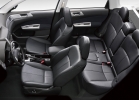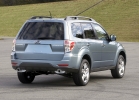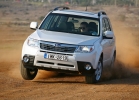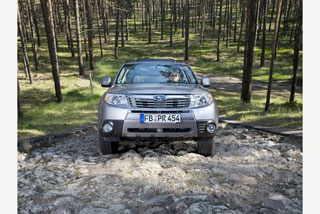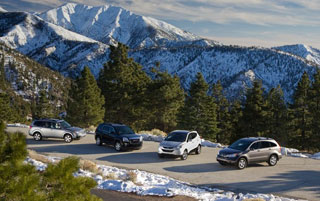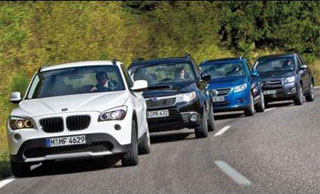Subaru Forester test drive since 2008 SUV
The first test drive of the new generation Subaru Forester
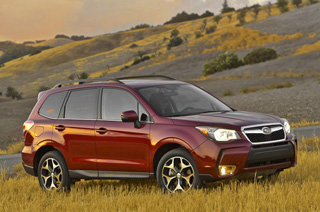 Main characteristics
Main characteristics Engine: 2.0 liters, turbocharged 4-cylinder horizontal-opposition
Power: 250 hp, 350 nm
Transmission: CVT (CVT)
Type of drive: Full
Landing scheme: 2+3
Fuel consumption: 12.3 city / 10.1 track
My trip was so swift that I did not even realize that I had been to Tokyo. He arrived on Friday, tested the car on Saturday and returned home on Sunday. This is a tough trip, deprived of sleep, associated with a significant change in temporary belts, but I stoically suffered all this, since the Subaru Forester 2014 of the model year is worthy of special attention. In truth, for the past fifteen years, this model has been a leading position among the Japanese automaker, when it comes to the North American sales market literally turned on crossovers.
Subaru organized an express tour so that many journalists, including Autoblog employees, had the opportunity to see, touch and test the new Forester before he went on sale abroad this month. In the US dealerships, he will appear only at the beginning of next year, and we will be able to see it without masking cloaks only at the end of the month as part of the Los Angeles car dealership, but for now we were allowed to ride a little behind the wheel of a disguised prototype, so a detailed review of the model will have to wait.
However, Subaru does not know that I, perhaps, are on the list of people who are undesirable to drive their new model, especially taking into account the change of several time zones. And all because I think the current Forester is overvalued and not powerful enough. Yes, it is equipped with a unique opposition engine, a full-wheel drive system and enjoys the immense love of Subaru brand fans, but this does not have any effect on me. Its high roof, a strange landing and a grotesque nostril on a hood of turbocharged models, I never liked it. In my opinion, Forester has always been somehow incomplete.
However, the fourth generation of the model promises to make some changes, as a result of which Forester has a chance to become a little more attractive both visually and in terms of dynamics, although I personally have the presence of the variator in the specification into an almost shock state. I was scared when I approached this Forester for the first time.
The value of this car in the process of becoming Subaru cannot be overestimated. Its sales are 25% of the total sales. In the USA, 22% Subaru, sold last year, are called Forester, and it is inferior only to Outback models. So it should be good, really good, especially in the presented segment, where beginners multiply, like mushrooms after rain.
Like most updated cars, the latest generation Forester has increased in size. The engineers made its wheelbase 2 cm larger, the total length of the car increased by 3.5 cm. In height, it added 2.5 cm. But at the same time, the center of gravity at the machine made a cunning move from Subaru engineers, given that the roof She became higher.
 In general, such changes may seem insignificant, but on the road, nevertheless, they give Forester excellent stability. This is a rather dubious compliment to the car, but it is in this segment that this characteristic is extremely important, moreover, the quality of the ride will always matter.
In general, such changes may seem insignificant, but on the road, nevertheless, they give Forester excellent stability. This is a rather dubious compliment to the car, but it is in this segment that this characteristic is extremely important, moreover, the quality of the ride will always matter. Invisible to the eye of refinements, additional insulation materials have significantly reduced the level of noise and vibration in the Subaru salon in the Subaru salon. One of the shortcomings of the previous Forester, which caused me immense irritation, was a terrible howling sound, which filled the salon when driving along concrete tracks when the wheels enters the joints of the plates. Now, these sounds will be absorbed by special insulating materials that this model of the crossover is referred to. Before that, Forester was full of different sounds that could easily cause a headache to the driver.
It also helps to get rid of unnecessary creaks and noise enlarged, according to Subaru engineers, by incredible 150%, the hardness of the twist to twist, which was most noticeable when passing the obstacle line outside the road. Even gravel and huge boulders did not bother the new Forester, although, I admit, a professional driver was sitting at that moment.
Looking at both models, new and old, you understand that they are different, but it is quite difficult to determine what exactly the difference is. Let's take a closer look. Subaru willingly agree with the assertion that the new model is rather evolution than the revolution, which in turn is very reminiscent of the statement of the official representatives of the Honda concern when demonstrating Civic updated for 2012. But in contrast, this car, which has been subjected to universal criticism for meaninglessness, Forester demonstrates more maturity. He became an adult, this is not a cheaper version of himself, he became better.
A pair of new bends appeared on the hood, the headlights were replaced, the roof line has also changed, now it is slightly tilted to the rear window, which generally makes the new Forester more streamlined for both observers and oncoming air flows. But the changes have occurred not only with appearance. The front stand of the body moved forward 2.5 cm, which made the angle of inclination of the windshield a little sharper and as a result improved visibility.
Tourbial models lost the corporate air intake on the hood, which positively affected aerodynamics. The abandonment of the inlet system located on top of the engine can greatly upset the loyal fans of the brand, but in my opinion, this is a significant step forward. It is quite interesting that such a noticeable change did not require the transfer of the intercooler located on top of the engine, for which the very nostril initially appeared on the hood. Instead, Subaru engineers have made changes to the structure of the lattice, and now the air to the intercooler enters through the false film of the radiator.
Other changes in the appearance of Forester include doors that are now lowering outside the body frame, and the thresholds have become part of the doors. The reason for this change is banal: this enables the driver to get into the car and get out of it without smoking the trouserhouses. Again, the maturity of such a solution delights me. Of course, it is fun and exciting to scatter the snow and dirt, but many of us need to go to work, and in clean trousers this is much more pleasant.
If in the basic configuration the new Forester is with the same 2.5-liter engine with opposition-located four working cylinders that outstand 170 hp. And 235 Nm of torque, then with a turbocharged 2-liter engine equipped with direct fuel injection, Subaru decided to experiment a little. As a result, he increased power, from 224 horses in the previous version up to 250 and 350 nm of torque.
 The basic model is equipped with either a six -speed mechanical transmission or the above variator. The turbocharged model can also be either with a six -a -a.m. or with a variator supplemented by steering wheel switches of eight conditioned velocities. Now I have to make a statement that I hate variators. I understand their undeniable benefit in minimizing fuel consumption, which is a priority for any modern automaker. But their manner is not to switch speeds and constant howl under load is simply infuriated with me.
The basic model is equipped with either a six -speed mechanical transmission or the above variator. The turbocharged model can also be either with a six -a -a.m. or with a variator supplemented by steering wheel switches of eight conditioned velocities. Now I have to make a statement that I hate variators. I understand their undeniable benefit in minimizing fuel consumption, which is a priority for any modern automaker. But their manner is not to switch speeds and constant howl under load is simply infuriated with me. And I was not in vain worried about CVT, because when I went to the basic model with such a transmission according to the secret testing test site, I waited for everything when it exploded. This, of course, did not happen, but the howl of the engine of our pre -production car was disappointed. The acceleration was smooth and fast, but the sound was contrary to the dynamics, since the transmission sought to find the optimal power range and stay in it. This is nervous. I would choose mechanics every day, and twice on Sunday.
In addition, I never liked the artificially set points of speed switching spell out in the brains of variators, precisely because they are artificial. However, Subaru managed to do everything right. Since the turbocharged version initially receives an additional 80 horses, these points seem quite natural. I am embarrassed to admit this, but I soon forgot to think that the turbocharged Forester is equipped with a variator.
Subaru claims that a new turbocharged engine can almost as effectively work on the fuel of the regolar class, although they still recommend refueling the car with premium gasoline if you want to get everything that it is capable of. In addition, according to Subaru, the Forester base model should spend 11.8 liters per 100 km in the city and 8.8 liters on the highway. The turbo control, according to their estimates, should consume 12.3 liters when driving around the city and 10 liters on the highway. For both models, this is an improvement in indicators against the background of previous generations. In addition, such results provide Subaru with one of the leading positions in this parameter in the class of crossovers.
Sit inside, and you will immediately see, feel and touch improvements. Perhaps most of all in the outgoing model I was upset by a dull salon. Fortunately, the new Forester things are much better. First of all, the salon has become much more spacious. Having increased the length and width of the body, the engineers managed to make the salon more. The resulting space is used wisely, everything is here in its place. Instead of rough plastic, on every sharp corner there are soft zones where you can put the elbows. Both rows of seats were designed from scratch, and they are very convenient. Even the steering wheel seems more pleasant and weighty. There are pleasant strokes and trifles everywhere, including the converted central panel, smoothly flowing down from top to bottom, a small screen between the sensors, displaying additional information for the driver. Plus, Subaru added a premium Harmon Kardon audio system with integrated AHA radio.
In fact, in general, the salon looks more mature. We were pleased with things such as folding seats of the second row, and options such as height-adjustable heights of the fifth door and the new Eyesight security system (it uses such technological innovations as adaptive cruise control and a warning system about the exit from the occupied strip). As a result, we did not have the impression that Forester is missing anything.
It is quite difficult to authoritatively judge the controllability and quality of the driving of the new Forester. I drove only a few laps on this car on an oval track and a couple along a winding test track. What can I say: the steering wheel is confident and balanced, and I was pleasantly surprised how well Forester holds. Even in steep turns, his body did not crunched and did not roll, and the all -wheel drive system gave additional confidence. It accelerates rapidly enough to cause a couple of satisfied grinders, but, after all, buying a similar car, you usually do not think about that, right?
If we assume that the main tasks of the new Forester are the breakdown of children to school, traveling and shopping, as well as traveling out of town on weekends, then it is simply amazing. Judging by what we managed to find out during a short communication with this car, it is good, very good. I can’t say that my trip to Japan was in vain.
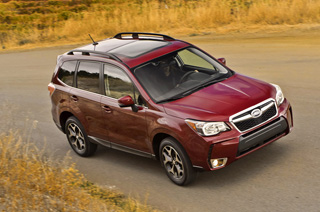
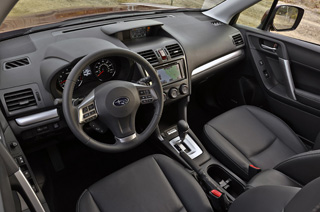
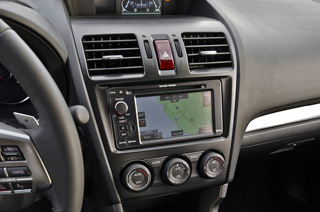
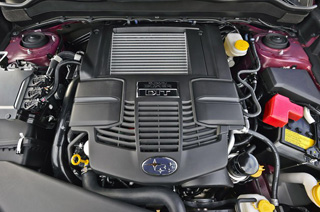
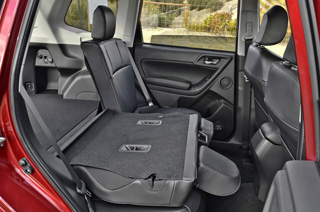


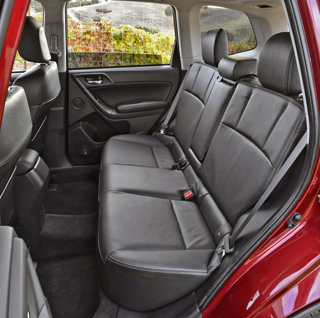
Author: Scott Bergesses
A source: Autoblog.com
Video Subaru Forester test drive since 2008
Subaru Forester Crash Video since 2008
Subaru Forester test drive since 2008
Subaru Forester Crash Test since 2008
Krassh Test: Detailed Information91%
Driver and passengers
73%
Pedestrians
91%
Children-passengers
86%
Active security system


